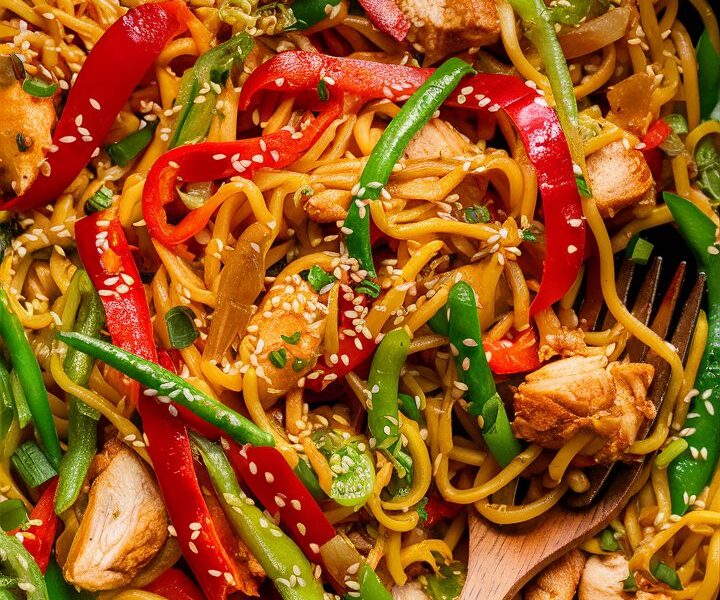Chicken Chow Mein with the Best Chow Mein Sauce
Introduction
Chicken Chow Mein is one of the most iconic dishes in Chinese cuisine and a global favorite when it comes to quick, flavorful, and satisfying meals. With its delightful balance of tender chicken, crisp vegetables, golden stir-fried noodles, and a richly flavored sauce, this dish has captured the hearts of food lovers worldwide.
The name “chow mein” literally translates to “fried noodles” in Cantonese, but its charm extends far beyond its simple definition. Depending on the region, chow mein can take many forms—from crispy noodles topped with sauce to stir-fried noodles tossed directly with vegetables and protein. The American-Chinese version of chow mein is typically stir-fried soft noodles combined with savory sauce, whereas Cantonese-style chow mein features golden crispy noodles with toppings served on top.
Homemade chicken chow mein is far more rewarding than takeout—not only does it allow you to control freshness, flavor, and ingredients, but it also ensures a healthier, more wholesome meal. The real magic lies in the chow mein sauce: a savory-sweet combination of soy sauce, oyster sauce, hoisin, sesame oil, and a few secret touches that make each bite unforgettable.
In this comprehensive guide, we’ll explore everything you need to know about making the perfect chicken chow mein at home. From the history and cultural variations to detailed step-by-step cooking instructions, expert tips, common mistakes to avoid, serving suggestions, and FAQs—this article has it all. By the end, you’ll feel confident enough to prepare restaurant-quality chow mein in your own kitchen.
History and Origins of Chow Mein

The story of chow mein begins in Northern China, where wheat-based noodles are a dietary staple. The term “chao mian” (炒面) directly translates to “stir-fried noodles.” Over time, this dish traveled across regions and continents, adapting to local tastes.
- Cantonese Chow Mein: Known for its crispy noodles, often pan-fried until golden, then topped with a flavorful sauce and stir-fried toppings.
- Shanghai Chow Mein: Uses thicker noodles and often features dark soy sauce for deeper color and richer taste.
- American-Chinese Chow Mein: Popularized by Chinese immigrants in the 19th and 20th centuries, this version includes softer stir-fried noodles with vegetables and proteins, often adjusted to suit Western palates.
- British Chow Mein: Often includes bean sprouts and additional sauces, making it slightly sweeter than traditional versions.
Today, chicken chow mein is one of the most beloved takeout dishes worldwide, often ordered alongside fried rice, dumplings, and spring rolls. But nothing compares to crafting it fresh at home with authentic flavors and high-quality ingredients.
Health Benefits of Chicken Chow Mein
While chow mein is often seen as a comfort food, when prepared thoughtfully, it can be a nutritious meal. Let’s break down the key benefits:
- Protein-Rich: Chicken provides lean protein, which supports muscle growth and repair.
- Vegetable-Packed: Cabbage, carrots, and bell peppers add fiber, vitamins, and antioxidants.
- Controlled Ingredients: Homemade chow mein allows you to use low-sodium soy sauce, healthy oils, and fresh vegetables for a lighter version.
- Balanced Meal: With carbs from noodles, protein from chicken, and vitamins from vegetables, this dish offers a complete nutritional profile.
- Customizable for Dietary Needs: It can be made gluten-free (using tamari or rice noodles), vegetarian (using tofu), or even low-carb (using zucchini noodles).
Essential Ingredients for Chicken Chow Mein
1. Chow Mein Noodles
The star of this dish is, of course, the noodles. Authentic chow mein noodles are made from wheat flour and eggs, giving them a slightly chewy texture.
- Best Choice: Fresh egg chow mein noodles (available in Asian grocery stores).
- Alternative Options:
- Dried chow mein noodles (boiled before stir-frying).
- Spaghetti or ramen noodles (not traditional but work in a pinch).
- Rice noodles (for a gluten-free version).
2. Chicken
For tender and flavorful results:
- Chicken breast – lean and absorbs sauce beautifully.
- Chicken thighs – juicier and more flavorful.
- Rotisserie chicken – great for a quick shortcut.
3. Vegetables
A colorful mix enhances both taste and texture:
- Shredded cabbage – adds crunch and sweetness.
- Carrots – natural sweetness and vibrant color.
- Bell peppers – crisp bite and freshness.
- Green onions – sharpness and aroma.
- Optional additions – bean sprouts, snow peas, broccoli, or baby corn.
4. The Chow Mein Sauce
The true soul of chicken chow mein lies in its sauce. Here’s the classic blend:
- Soy sauce (preferably low sodium) – umami base.
- Oyster sauce – depth and slight sweetness.
- Hoisin sauce – sweet, tangy, and aromatic.
- Sesame oil – nutty fragrance.
- Chicken broth – body and moisture.
- Cornstarch – thickening agent.
- Sugar – balances the salty notes.
- Optional: Ginger, garlic, chili flakes, or rice vinegar for complexity.
Step-by-Step Instructions for Chicken Chow Mein

Making chow mein is all about preparation and speed. Once you start cooking, things move fast—so have all your ingredients ready.
Step 1: Prepare the Noodles
- Boil chow mein noodles according to package directions.
- Drain and rinse under cold water to prevent sticking.
- Toss with a drizzle of sesame oil and set aside.
Step 2: Marinate and Cook the Chicken
- Slice chicken breast into thin strips.
- Marinate with 1 tsp soy sauce, ½ tsp cornstarch, and a splash of sesame oil for 10 minutes.
- Heat 1 tbsp vegetable oil in a wok.
- Add chicken in a single layer, sear for 2 minutes, then stir-fry until fully cooked.
- Remove and set aside.
Step 3: Stir-Fry the Vegetables
- In the same wok, add another tablespoon of oil.
- Sauté minced garlic and ginger for 30 seconds until fragrant.
- Add cabbage, carrots, and bell peppers. Stir-fry for 2–3 minutes.
- Vegetables should remain slightly crisp for texture.
Step 4: Make the Chow Mein Sauce
- In a small bowl, whisk together soy sauce, oyster sauce, hoisin sauce, sesame oil, sugar, chicken broth, and cornstarch.
- Adjust consistency with extra broth if needed.
- Taste and balance with chili flakes (spicy) or rice vinegar (tangy).
Step 5: Combine Everything
- Add cooked noodles to the wok with vegetables.
- Pour in the sauce and toss everything together.
- Return chicken to the wok and stir-fry for 2 minutes.
- Top with sliced green onions and serve hot.
Pro Tips for the Best Chow Mein
- Use High Heat: Stir-frying requires a hot wok for that smoky “wok hei” flavor.
- Don’t Overcrowd the Pan: Cook chicken, veggies, and noodles separately for the best texture.
- Use Fresh Noodles: They provide authentic chewiness compared to dried.
- Keep Vegetables Crisp: Overcooked vegetables lose their crunch and freshness.
- Experiment with Proteins: Shrimp, beef, pork, or tofu work just as well.
- Balance the Sauce: Taste before adding to noodles—adjust sweetness, saltiness, or spiciness.
Serving Suggestions & Pairings
Chicken chow mein is satisfying on its own, but pairing it with sides creates a complete meal.
- Spring Rolls – Crispy and savory.
- Egg Drop Soup – Light and comforting.
- Dumplings – Steamed or pan-fried appetizers.
- Crab Rangoon – Creamy and crunchy contrast.
- Asian Cucumber Salad – Refreshing palate cleanser.
For beverages, serve with iced green tea, jasmine tea, or even a light sparkling drink.
Storage and Reheating
- Refrigeration: Store leftovers in an airtight container for up to 3 days.
- Freezing: Not recommended—noodles lose texture.
- Reheating: Best done in a hot wok with a splash of broth. Microwave with a damp paper towel for a quick option.
Common Mistakes and How to Fix Them
- Soggy Noodles – Always rinse noodles after boiling and stir-fry quickly.
- Overcooked Vegetables – Stir-fry on high heat for just 2–3 minutes.
- Bland Flavor – Taste and adjust sauce before mixing.
- Dry Texture – Add more broth or a splash of water while stir-frying.
- Overcrowding – Cook in batches to maintain proper heat.
Nutritional Information (Per Serving)
(Approximate values – may vary depending on ingredients)
- Calories: 420
- Protein: 28g
- Carbohydrates: 50g
- Fat: 12g
- Fiber: 4g
- Sodium: 950mg
FAQs (Frequently Asked Questions)

Q1: Can I make chow mein gluten-free?
Yes, use gluten-free soy sauce (tamari) and rice noodles instead of wheat noodles.
Q2: What’s the difference between chow mein and lo mein?
Chow mein is stir-fried with a lighter coating of sauce, often with crispier noodles, while lo mein has softer noodles tossed in more sauce.
Q3: Can I prepare the sauce in advance?
Absolutely. Make the sauce up to 3 days ahead and store in the fridge. Shake before using.
Q4: How can I make it vegetarian?
Replace chicken with tofu, mushrooms, or just extra vegetables.
Q5: Why do my noodles clump together?
Rinse them after boiling and toss with oil before stir-frying.
Q6: What oil is best for stir-frying?
Neutral oils with high smoke points, such as vegetable, peanut, or canola oil.
Q7: Can I make chow mein spicy?
Yes, add chili flakes, sriracha, or sliced fresh chili peppers.
Conclusion
Chicken Chow Mein is more than just a takeout favorite—it’s a versatile, comforting, and flavorful dish that you can easily master at home. By focusing on fresh ingredients, a well-balanced sauce, and proper stir-frying techniques, you can create a dish that rivals your favorite restaurant.
Whether you enjoy it as a weeknight dinner or serve it at gatherings, chow mein’s combination of chewy noodles, savory chicken, and crisp vegetables makes it a timeless classic. With the tips, tricks, and recipe outlined in this guide, you’ll be able to craft the best chicken chow mein with the perfect chow mein sauce every time.





